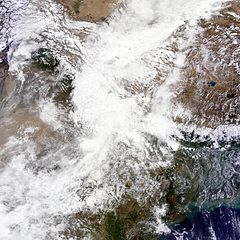2013 North India floods

NASA satellite imagery of Northern India on 17 June, showing rainclouds that led to the disaster
|
|
| Location |
India Uttarakhand Himachal Pradesh Uttar Pradesh Nepal Far Western Region Mid Western Region |
|---|---|
| Deaths | 5,748 |
| Property damage | 4,200 villages were affected |
In June 2013, a multi-day cloudburst centered on the North Indian state of Uttarakhand caused devastating floods and landslides becoming the country's worst natural disaster since the 2004 tsunami. The reason the floods occurred was that the rainfall received was on a larger scale than the regular rainfall the state usually received . The debris blocked up the rivers, causing major overflow. The main day of the flood is said to be on 16 June 2013. Though some parts of Himachal Pradesh, Haryana, Delhi and Uttar Pradesh in India experienced the flood, some regions of Western Nepal, and some parts of Western Tibet also experienced heavy rainfall, over 89 % of the casualties occurred in Uttarakhand. As of 16 July 2013[update], according to figures provided by the Uttarakhand government, more than 5,700 people were "presumed dead." This total included 934 local residents.
Destruction of bridges and roads left about 100,000 pilgrims and tourists trapped in the valleys leading to three of the four Hindu Chota Char Dham pilgrimage sites. The Indian Air Force, the Indian Army, and paramilitary troops evacuated more than 110,000 people from the flood ravaged area.
From 14 to 17 June 2013, the Indian state of Uttarakhand and adjoining areas received heavy rainfall, which was about 375% more than the benchmark rainfall during a normal monsoon. This caused the melting of Chorabari Glacier at the height of 3800 metres, and eruption of the Mandakini River which led to heavy floods near Gobindghat, Kedar Dome, Rudraprayag district, Uttarakhand, Himachal Pradesh and Western Nepal, and acute rainfall in other nearby regions of Delhi, Haryana, Uttar Pradesh and some parts of Tibet.
...
Wikipedia
